Discover Delicious Easy Veggie Casserole Recipes
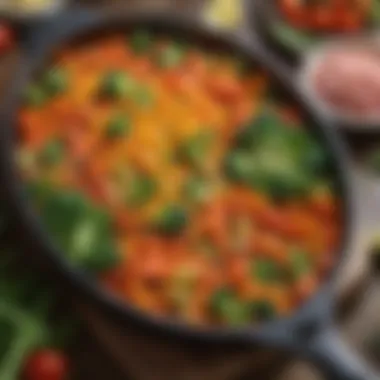
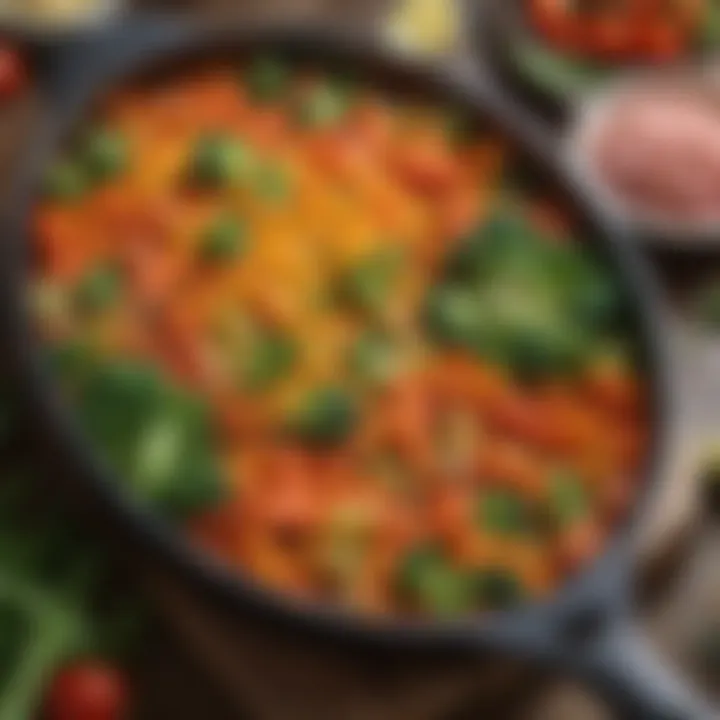
Intro
Easy veggie casseroles represent a harmonious blend of flavor, nutrition, and convenience, making them a desirable choice for many people. These dishes can cater to various dietary preferences, enabling cooks to utilize seasonal vegetables and personal ingredients. This guide delves into the world of veggie casseroles, presenting insightful information ranging from preparation techniques to recipe ideas tailored for health-conscious individuals and busy families.
Vegetarian and plant-based diets are gaining popularity due to their health benefits and environmental impact. As a result, the versatility of casseroles allows for endless variation in recipes. Whether you want a comforting meal after a long day or something quick to prepare for a gathering, veggie casseroles can certainly deliver.
The subsequent sections will provide you a roadmap for creating simple, delicious, and nutritious veggie casseroles that can easily become staples in any household.
"Casseroles offer a great opportunity to embrace creativity in the kitchen while ensuring a balanced diet."
As we proceed, we will explore specific recipes, ingredient lists, and tips that make these dishes a practical choice, appealing to food lovers of all ages.
Intro to Veggie Casseroles
Veggie casseroles represent a unique intersection between culinary creativity and practicality. They are not only adaptable to various ingredients but also provide numerous health advantages. This article explores the significance of veggie casseroles, explaining how they can be simplified for anyone looking to create delicious meals.
Defining Veggie Casseroles
Veggie casseroles are essentially baked dishes that consist predominantly of vegetables. They often include layers of vegetables, grains, and sometimes dairy or plant-based proteins. The cooking method usually involves combining these elements in a baking dish and baking them until cooked through and flavorful.
The beauty of veggie casseroles lies in their flexibility. Home cooks can use whatever vegetables they have on hand, making these dishes perfect for both seasonal cooking and using leftovers. They can be vegetarian or even vegan, catering to diverse dietary preferences. Typically, a casserole will feature a baking time that helps meld the flavors, resulting in a rich, hearty dish.
Cultural Significance of Casseroles
The concept of casserole has a rich history and varies across cultures. Many cuisines incorporate a similar idea—combining multiple ingredients into a single dish that is easy to prepare and serve. In the United States, casseroles became popular in the 1950s as a reflection of convenience cooking, often featured in family gatherings and potlucks.
Globally, dishes like moussaka in Greece and lasagna in Italy share traits with veggie casseroles. They not only offer comfort food but also highlight local ingredients, connecting traditions with modern cooking. Casseroles serve as a cultural vessel, allowing families to celebrate their heritage while adapting to contemporary culinary practices. The casserole remains a staple, illustrating its durability and relevance in kitchens worldwide.
Nutritional Benefits of Veggie Casseroles
Veggie casseroles serve as an excellent way to pack nutrition into a single dish. Their ability to combine multiple vegetables, grains, and proteins makes them a suitable choice for those wanting a healthy meal. In this section, we will delve into the various nutritional benefits, which include fiber content, vitamins and minerals, and their role as low-calorie meal options. Each of these aspects contributes to the casserole's reputation as a nourishing dish worthy of any table.
Rich Sources of Fiber
Fiber is an essential component of a balanced diet, and veggie casseroles are excellent sources of this nutrient. Much of the fiber comes from the variety of vegetables included in the dish. Common choices such as broccoli, beans, and carrots contribute significantly to daily fiber intake.
Incorporating high-fiber ingredients aids digestion and promotes a feeling of fullness, which can help manage weight. For those who seek to improve overall gut health, a fiber-rich casserole is a thoughtful choice. This benefits both adults and children, encouraging healthy eating habits from a young age.
Vitamins and Minerals from Fresh Produce
The use of fresh vegetables in casseroles provides a broad spectrum of vitamins and minerals. For example, leafy greens like spinach are rich in iron, while tomatoes offer a good dose of vitamin C and antioxidants. Each element not only adds flavor but also boosts the casserole’s nutritional profile.
When a casserole includes diverse colors of vegetables, it maximizes the range of nutrients consumed.
A balanced veggie casserole may look like this:
- Dark leafy greens (spinach, kale)
- Colorful vegetables (bell peppers, carrots)
- Root vegetables (sweet potatoes, beets)
This combination ensures a variety of vitamins that support immunity, vision, and skin health.
Low-Calorie Meal Options
For individuals watching their calorie intake, veggie casseroles can offer a satisfying yet low-calorie meal solution. By emphasizing vegetables and using grains like quinoa or brown rice in moderation, these dishes can be filling without excessive calories.
Furthermore, many casserole recipes allow for substitutions of high-calorie ingredients with lighter options without losing flavor. For instance, using low-fat cheese instead of regular cheese or substituting cream with Greek yogurt can significantly lower calorie content while still providing creaminess.
As such, veggie casseroles not only cater to those seeking nutritious meals but can also accommodate specific dietary restrictions. By keeping casseroles light yet nutritious, consumers can prioritize their health without giving up on great taste.
A well-prepared veggie casserole not only feeds the body but also significantly contributes to overall health, making it a valuable addition to any meal plan.
In summary, the nutritional benefits of veggie casseroles are numerous. They provide rich sources of fiber, essential vitamins and minerals, and can serve as low-calorie meals. Introducing these dishes into your culinary repertoire can lead to improved dietary habits and enhanced well-being.
Essential Ingredients for Veggie Casseroles
When it comes to creating an easy veggie casserole, the quality and selection of ingredients play a crucial role. These elements not only contribute to the flavor but also enhance the nutritional value of the dish. Each ingredient serves a specific purpose in building texture, taste, and health benefits, making it essential to choose wisely. Understanding the various components that should go into veggie casseroles is key to crafting a satisfying meal.
Vegetable Selection
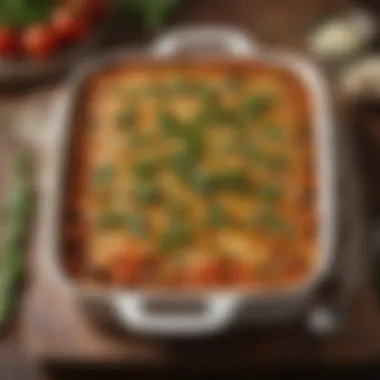
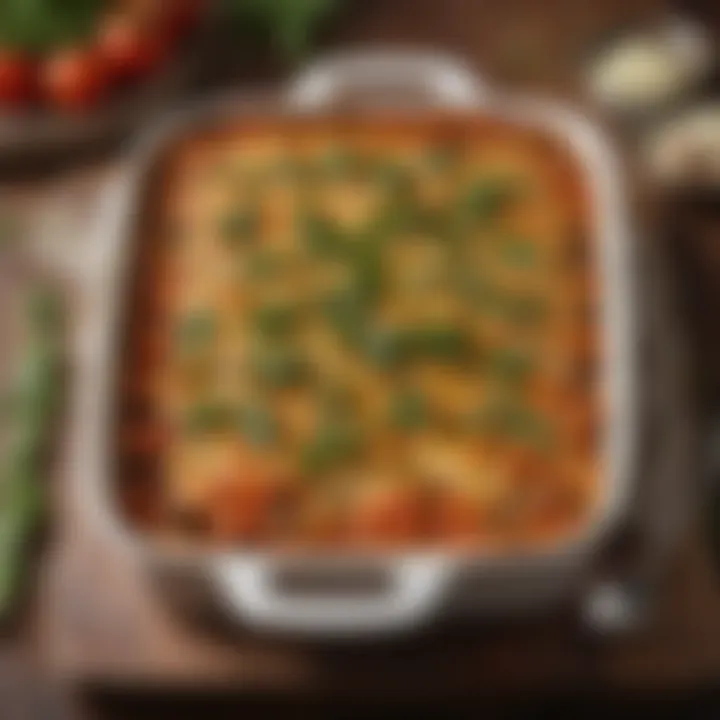
Choosing the right vegetables is paramount in any veggie casserole. Fresh produce brings flavor and nutrition to the dish. Common choices include broccoli, zucchini, bell peppers, and carrots. These vegetables provide a range of vitamins and minerals. For instance, broccoli is rich in Vitamin C and K, while bell peppers offer a significant amount of Vitamin A.
Considerations when selecting vegetables:
- Seasonality: Fresh, in-season veggies taste better and often have more nutrients.
- Textural variety: Combining crisp and tender vegetables can improve the overall texture of the casserole.
- Nutritional content: Aim for a colorful assortment; different colors usually indicate diverse nutrients.
Starches and Grains
Starches and grains are foundational to veggie casseroles. They not only serve as a base but also help in making the dish more filling. Common choices include rice, quinoa, and pasta. Each option provides a unique flavor and absorbs the juices from vegetables and sauces effectively.
Benefits of including starches and grains:
- Satiety: They help create a sense of fullness, making the casserole a more complete meal.
- Fiber: Whole grains like quinoa provide additional fiber, which is vital for digestive health.
- Versatility: Grains can easily adapt to different cuisines, allowing for diverse flavor profiles.
Cheeses and Creams
Dairy products such as cheeses and creams add richness and creaminess to casseroles. Popular options include mozzarella, cheddar, and ricotta. They enhance the texture and bind the ingredients together, creating a pleasing mouthfeel.
Considerations for using cheeses and creams:
- Flavor pairing: Choose cheeses that complement the vegetables, like sharp cheddar for heartier vegetables or feta for Mediterranean-style casseroles.
- Dietary considerations: For those who are lactose intolerant, look for plant-based alternatives that still provide a creamy texture.
- Balance: Use cheese moderately to avoid overpowering the other flavors.
Herbs and Spices
Herbs and spices are essential for elevating the flavors in veggie casseroles. They can range from fresh herbs like basil and parsley to dried spices like cumin and paprika. The right combination can transform a simple dish into a flavorful masterpiece.
Tips for incorporating herbs and spices:
- Fresh is best: Whenever possible, opt for fresh herbs. They yield a more vibrant flavor compared to dried herbs.
- Balance flavors: Start with small amounts and adjust according to taste. Too much seasoning can overpower the natural flavors of the vegetables.
- Regional themes: Different herbs can evoke specific cuisines, allowing for creative exploration when preparing casseroles.
Each ingredient in a veggie casserole contributes not only to the flavor but also to the overall nutritional profile, enhancing the meal's appeal to health-conscious individuals.
Considering these essential ingredients will pave the way for creating delicious and nutritious veggie casseroles, satisfying both taste and dietary needs.
Preparation Techniques
Preparation techniques are crucial in the world of veggie casseroles. They enhance flavors and textures, ensuring a pleasant eating experience. Proper techniques lead to a well-cooked casserole that highlights the natural goodness of vegetables. A clear understanding of chopping, sautéing, layering, and baking ensures that the cooking process is not only efficient but also effective.
Chopping and Sautéing Vegetables
Chopping vegetables uniformly is vital. It ensures even cooking throughout the casserole. When chopping, consider the type of vegetable. For instance, carrots and bell peppers should be cut smaller than potatoes for even texture. Sauteing is a technique that adds depth to the dish. It allows the natural sugars in vegetables to caramelize, enhancing their flavor.
To sauté effectively, use a suitable amount of oil in a warm pan. Start with harder vegetables, like carrots and celery, which need more time to soften. Add softer vegetables later to prevent overcooking. Use salt to help release moisture and draw out flavors. For a delightful experience, consider adding garlic or onions during the sauté process for added richness.
Layering Casseroles for Flavor
Layering is a strategic approach in casserole preparation. It creates distinct flavors in each bite. Start with a sturdy base of starch, be it rice or potatoes. This absorbs moisture and provides structure. Then, add a generous layer of sautéed vegetables. Next, you can introduce sauces or cheeses for richness. Alternate layers to build complexity and ensure equal distribution of flavors.
One effective method is to layer ingredients in a pattern. For example, alternate between veggies and starches. This design helps achieve an even cook and maintains flavor integrity. Consider the color and texture as you layer; this can enhance visual appeal.
Baking Techniques
Baking a casserole is more than simply putting it in the oven. The right temperature and time are essential for a perfectly baked dish. Generally, most veggie casseroles bake well at 350°F. However, you should monitor closely as each oven can vary. To achieve a golden top, consider broiling the casserole for the last few minutes. This method adds a pleasing texture.
Covering the casserole during early baking is beneficial. It retains moisture and allows the ingredients to soften. After a while, remove the cover to let the top crisp up. Don't forget to allow the casserole to rest after baking. This helps the flavors meld and makes serving easier.
"Preparation is key to ensure that each veggie casserole is both appealing and delicious. Understanding each step sheds light on achieving the best outcomes."
Applying these preparation techniques will elevate your veggie casserole, making it not just a meal, but a delightful experience. Readers should feel confident in experimenting and creating their unique casseroles at home.
Easy Veggie Casserole Recipes
Easy veggie casseroles represent a harmonious blend of taste, nutrition, and convenience. These dishes serve as perfect solutions for busy families and health-conscious individuals seeking to incorporate more vegetables into their diets. Casseroles are versatile; they can adapt to a wide range of ingredients and dietary preferences. Moreover, they often provide a hearty meal in one dish, making them a practical choice for weeknight dinners or meal prep.
When creating easy veggie casseroles, one can focus on seasonal vegetables to enrich flavor and nutrient content. The possibilities are vast, ranging from traditional vegetable combinations to more exotic mixes. Each recipe can serve many, be easily stored, and reheated, ensuring that leftovers are never wasted. boldAdditionally, incorporating legumes and whole grains can enhance the protein content, ensuring a well-rounded meal./bold
Classic Vegetable Casserole
The classic vegetable casserole serves as a foundational recipe for many households. It typically includes ingredients such as carrots, green beans, and corn, all of which are layered with a creamy sauce, often with the help of a cheese or a starch to bind the elements together. One can opt for a homemade white sauce or choose cream of mushroom soup for an easier version.

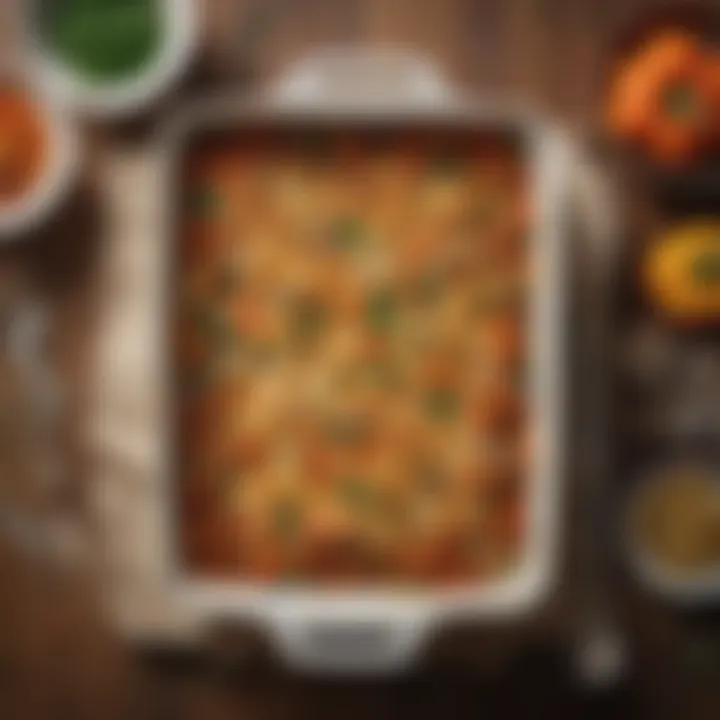
The allure of this casserole lies in its simplicity. It requires minimal preparation, making it an inviting option for novice cooks. One of the main benefits is that it can use whatever vegetables are on hand, thus minimizing waste. Baking this dish not only enhances the flavors through caramelization but also creates a satisfying texture.
Mexican Quinoa Casserole
The Mexican quinoa casserole introduces bold flavors influenced by traditional Mexican cuisine. This dish combines protein-rich quinoa with black beans, diced tomatoes, corn, and spices such as cumin and chili powder. The result is a filling option that caters well to both vegetarians and meat lovers alike.
Quinoa is a super grain and is gluten-free, adding to the nutritional value. Topping the casserole with avocado or fresh cilantro before serving adds brightness. This dish can easily be modified, accommodating any seasonal vegetables or personal preferences, thus enhancing its appeal for varied dietary needs.
Spinach and Ricotta Casserole
The spinach and ricotta casserole takes advantage of the creaminess from ricotta cheese melded with the health benefits of spinach. This dish often layers spinach between sheets of pasta or alongside roasted vegetables, combined in a creamy mixture of ricotta, egg, and cheese. This rich, but not overly heavy, casserole is an ideal option for a comforting meal.
In terms of health benefits, spinach offers a wealth of vitamins and minerals, notably iron. Using whole grain pasta can increase fiber content, making this casserole an excellent source of energy while satisfying the palate. The texture is creamy and the flavors are bright, appealing to those who appreciate mild but flavorful dishes.
Mediterranean Veggie Bake
The Mediterranean veggie bake emphasizes seasonal vegetables and herbs characteristic of Mediterranean cuisine. Common components include zucchini, eggplant, bell peppers, and aromatic herbs like oregano and basil. Layering these ingredients with olive oil and feta cheese creates a distinctive salad-casserole hybrid.
This dish not only provides an explosion of flavors but is also rich in healthy fats thanks to olives and olive oil. The Mediterranean diet is well-regarded for its benefits to heart health, making this casserole an excellent choice for those mindful of their dietary choices. It can be served as a main course or a delightful accompaniment to grilled meats or fish.
Sweet Potato and Kale Casserole
The sweet potato and kale casserole is a nutrient-packed option that highlights the sweet potato's natural sweetness. Combining it with the earthy flavors of kale, this casserole is both hearty and comforting. The addition of a creamy sauce—whether made from nutritional yeast for a vegan variation or a traditional cheese sauce—complements the base ingredients effectively.
Sweet potatoes offer a rich source of vitamins, particularly vitamin A, while kale is a power food for its antioxidant properties. Baking this dish creates a delightful combination of textures, with the topping often achieving crispiness while retaining moisture in the center. This casserole stands out for its vibrant colors and robust nutritional profile, making it an appealing dish for various occasions.
Storage and Reheating Tips
Storing and reheating veggie casseroles correctly is essential to retain their flavor and texture. This section focuses on effective methods to ensure that your casseroles maintain their quality over time. Understanding how to store leftovers properly can save time and money, while also reducing food waste. Appropriate reheating techniques help in preserving the taste and nutritional benefits of the ingredients. These tips will help you enjoy your veggie casseroles days after preparation, maximizing their enjoyment.
Proper Storage Methods
Proper storage of veggie casseroles can greatly impact their taste and freshness. After cooking, allow the casserole to cool to room temperature. This helps to prevent condensation, which can make leftovers soggy. Once cooled, wrap the casserole tightly with plastic wrap or foil, or transfer it into an airtight container. This will protect the dish from freezer burn if stored in the freezer.
For refrigeration, veggie casseroles can typically be stored for about three to five days. Ensure the refrigerator is kept at a consistent temperature of 40°F or below. If you have more leftovers than you can consume in this time frame, consider freezing them. Most veggie casseroles freeze well for up to three months. However, it is advisable to label containers with the date and contents, so you can manage your stored meals effectively.
Reheating Techniques to Preserve Flavor
Reheating veggie casseroles requires care to ensure that they do not dry out or lose flavor. There are several methods to do this effectively.
- Oven Reheating: This method is ideal for retaining the crispness of toppings. Preheat your oven to 350°F. Place the casserole in an oven-safe dish, cover it with foil to avoid direct heat, and heat for about 20 to 30 minutes or until evenly warmed through. For the last five minutes of cooking, you may remove the foil to crisp the top.
- Microwave Reheating: This is quicker, but it may result in uneven heating. To microwave effectively, place a serving in a microwave-safe dish. Cover the dish with a microwave-safe lid or plastic wrap, leaving a small gap for steam to escape. Heat on medium power in one-minute intervals, stirring in between, until heated through.
- Stovetop Reheating: For a quick method, you can reheat on the stove. Add a splash of water or broth to the casserole and heat on low heat in a pan. Stir frequently to prevent sticking and ensure even heating.
Be cautious not to overheat the casserole, as this can lead to a loss of texture and flavor.
Using these storage and reheating methods will help you to enjoy your veggie casseroles at their best even days after cooking.
Casseroles for Special Diets
In today's diverse culinary landscape, it is essential to recognize the growing needs of various dietary preferences. Casseroles can be adapted to fit many diets, making them appealing to a wide audience. By exploring casserole options that cater specifically to gluten-free, vegan, and paleo lifestyles, this section illustrates the versatility of veggie casseroles. It emphasizes the idea that maintaining dietary restrictions does not mean sacrificing flavor or satisfaction. These adaptations not only enhance the accessibility of casseroles but also promote inclusivity at meal times.
Gluten-Free Options
Gluten intolerance affects many individuals. Ensuring that casseroles are gluten-free allows those with sensitivities to enjoy this comforting dish without health concerns. Many traditional casseroles utilize grains as a base or thickening agent, including breadcrumbs or pasta. However, gluten-free versions can use alternatives like quinoa, rice, or gluten-free pasta. These options preserve texture while adding nutritious elements.
In addition, substituting flour with gluten-free thickeners such as cornstarch or arrowroot powder can maintain the richness of the dish. For those looking to try gluten-free casserole recipes, consider using ingredients like:
- Brown rice: Great for a hearty base.
- Chickpeas: These legumes add protein and fiber, enhancing the nutritional profile.
- Zucchini noodles: Function well as a creative replacement for pasta.
Overall, having gluten-free options in veggie casseroles means more individuals can enjoy delicious meals together.
Vegan Casserole Variants
Vegan diets exclude all animal products, including dairy and meat. This can make traditional casseroles challenging as they often contain cheese or creamy sauces for flavor. However, with the rise of plant-based cooking, many vegan alternatives now exist that do not compromise on taste or texture. Common substitutes include nutritional yeast for cheesiness and cashew cream for a rich texture.
When creating vegan casseroles, one can incorporate various ingredients such as:
- Lentils or black beans: For protein and texture.
- Non-dairy cheeses: Available in many flavors, these can replicate traditional cheese in casseroles.
- Leafy greens and vegetables: Spinach, kale, and broccoli increase the nutrient content and add moisture.
The creativity in vegan casseroles allows for endless customization, making it possible to enjoy classic dishes while adhering to dietary choices.


Paleo-Friendly Casseroles
The paleo diet focuses on whole foods similar to what our ancestors might have eaten. This includes lean meats, fish, vegetables, fruits, nuts, and seeds. Dairy, grains, and processed foods are typically avoided. Preparing a paleo-friendly casserole usually involves substituting grains and certain non-paleo ingredients with whole foods.
For example, sweet potatoes can act as a starch base, while cauliflower can be processed to create a rice substitute. Using high-quality meats or seafood along with fresh vegetables makes for a nutritious meal. Essential paleo ingredients to consider include:
- Butternut squash: Adds a sweet element and serves as a great base.
- Chicken or turkey: Lean protein sources work well in casseroles.
- Avocado oil: Ideal for cooking, it adds healthy fats.
By implementing these substitutions, paleo-friendly casseroles become not only suitable for those on specific diets but also scrumptious and satisfying for everyone.
Exploring Global Variations of Veggie Casseroles
Casseroles are more than just a convenient dish; they hold cultural significance and reflect regional ingredients and cooking practices. In exploring global variations of veggie casseroles, we see how local produce and culinary traditions can inspire different flavor profiles and textures. This exploration not only broadens the scope of what a veggie casserole can be, it also introduces the cook to diverse techniques and combinations that can elevate simple ingredients into hearty meals. Understanding these variations allows for creativity in the kitchen and helps to appreciate the cultural stories behind different dishes.
Italian-Inspired Casseroles
Italian cuisine is renowned for its bold flavors and emphasis on quality ingredients. When it comes to veggie casseroles, this influence can be incredibly enriching. Key ingredients often include eggplant, zucchini, and bell peppers, alongside staples like tomato sauce, herbs, and cheeses such as mozzarella and parmesan.
These casseroles often feature layers of vegetables, much like lasagna, allowing for a beautiful presentation and delightful taste. One popular Italian-inspired casserole is the Ratatouille Casserole. Here, sliced vegetables are arranged in an elegant pattern, baked in a tomato and herb sauce, and finished with a sprinkle of cheese. The beauty of Italian casseroles lies in their simplicity, informed by seasonal produce and regional taste preferences.
Consider experimenting with ingredients like ricotta cheese or even incorporating grains such as polenta for a different texture. The versatility of Italian-inspired veggie casseroles opens doors for both traditional and modern interpretations.
Indian Vegetable Bakes
Indian cuisine offers another exciting avenue for veggie casseroles, presenting a spectrum of spices and flavors that are rich and complex. The use of seasonal vegetables combined with spices such as cumin, coriander, and turmeric can transform a simple casserole into an aromatic event.
A Paneer and Vegetable Bake illustrates this beautifully. Paneer, a type of Indian cheese, provides protein and creaminess, while mixed vegetables add vitamins and fibers. Layering these ingredients with curry spices and perhaps a yogurt sauce results in a fulfilling dish that resonates with many palates.
Incorporating lentils or chickpeas can boost the protein content while also adding texture. Indian veggie bakes are often accompanied by flatbreads or rice, creating a comforting meal suitable for any occasion.
Both Italian and Indian variations showcase the capability of veggie casseroles to adapt across culinary traditions. By trying out these global perspectives, one can widen their cooking repertoire and appreciate the richness that comes from combining different culinary practices.
Pairing Options for Veggie Casseroles
Pairing options for veggie casseroles are crucial for enhancing both flavor and nutritional balance. The right accompaniments can elevate a simple casserole into a well-rounded meal. It introduces contrasting textures and flavors, which can enhance a diner's experience. Moreover, thoughtfully paired items can help emphasize the freshness of the vegetables and the richness of the casserole.
Salads and Casseroles
Salads serve as an excellent complement to veggie casseroles, offering a refreshing contrast that can brighten a hearty meal. A crisp salad can balance out the warmth and density of a baked casserole. Consider using seasonal greens and colorful vegetables to provide a visual appeal.
For example, a mixed greens salad with cherry tomatoes and cucumbers can add a light, crunchy texture before the heavier casserole. Adding a vinaigrette dressing can infuse acidity that cuts through the richness of dishes like spinach and ricotta casserole. Here are some salad ideas you can pair with a veggie casserole:
- Caprese Salad
This simple combination of mozzarella, tomatoes, and basil can enhance an Italian-inspired casserole. - Greek Salad
With feta cheese, olives, and a lemon dressing, it can complement Mediterranean veggie bakes beautifully. - Quinoa Salad
Healthy, nutty quinoa tossed with herbs can provide a protein boost alongside your casserole.
A balanced meal is not only about taste; it's about the overall nutritional profile. Layering different food groups, such as grains, proteins, and vegetables, keeps the meal diverse and interesting.
Serving with Bread and Grains
Serving veggie casseroles with bread or grains can provide a fulfilling element to the meal. Bread options range from artisan loaves to more rustic variations, serving not only as a side but also as a tool to scoop up casserole portions. For example, sourdough or whole grain bread can accompany a southwest quinoa casserole, offering additional texture.
Alternatively, grains such as rice or farro can form the base of your meal, creating a heartier plate. Pairing grains with casseroles is particularly useful for adding fiber and nutrients. Consider these grains as perfect companions:
- Brown Rice
A nutritious base that pairs well with almost any vegetable dish. - Quinoa
A protein-rich option that complements a range of flavors, especially good with Mexican casseroles. - Barley
With its chewy texture, it pairs well with hearty casseroles, adding more depth.
Ultimately, the right pairing can transform a good casserole into a satisfying and complete meal, making it more enjoyable for family gatherings or simple weeknights.
The End
The exploration of veggie casseroles holds significant value for both everyday cooking and the broader culinary landscape. This article has examined various aspects of veggie casseroles, demonstrating not only their versatility but also their nutritional advantages. By understanding the key ingredients, preparation methods, and storage techniques, readers can appreciate the simplicity and satisfaction that comes with these dishes.
One main feature of veggie casseroles is their adaptability to different dietary requirements. Whether one follows a gluten-free, vegan, or paleo diet, there are countless ways to modify a casserole recipe. This flexibility makes it easier for families to enjoy meals together, accommodating various preferences and health considerations.
Additionally, the nutrient-rich ingredients found in these casseroles enhance their appeal. They provide essential vitamins, minerals, and fiber, which contribute to overall health. This article has highlighted how utilizing fresh produce can lead to flavorful and wholesome meals that are not only enjoyable but also beneficial.
Moreover, the preparation techniques discussed help ensure that each casserole retains its unique taste and texture. From layering strategies to suitable baking methods, these elements are crucial for crafting delicious meals that can be easily reheated.
To sum up, veggie casseroles represent a bridge between convenience and culinary exploration. They can energize your regular meals while ensuring nutritious benefits. Those who have read the entire article should walk away with the knowledge to create their own veggie casseroles, appreciating their potential to bring family and friends together at the dining table.
Final Thoughts on Veggie Casseroles
Veggie casseroles provide a wonderful avenue to express creativity in the kitchen. They can be customized to fit seasonal vegetables, personal preferences, or specific dietary needs. In this way, every dish can become unique for the individual or family preparing it. Casseroles can also serve as a practical solution for meal prep, allowing people to prepare larger portions that can be enjoyed throughout an extended period.
Utilizing leftovers or surplus vegetables from the fridge can reduce food waste, which adds an aspect of sustainability to cooking. This approach aligns perfectly with the increasing focus on environmental awareness in present-day lifestyles.
Ultimately, veggie casseroles resonate with many because they epitomize a harmonious blend of nourishment, practicality, and creativity. They can satisfy hunger while providing a sense of comfort and community at the dining table.







